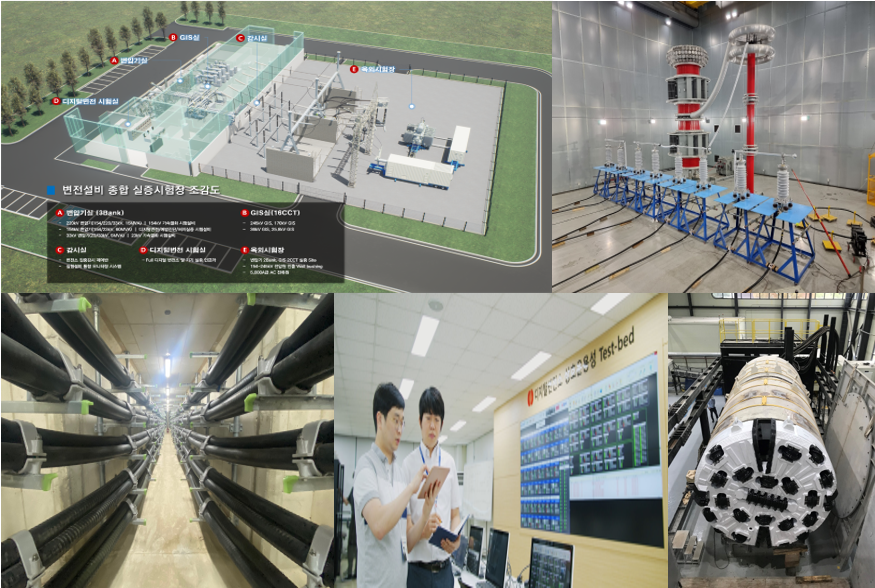Transmission & Substation
Fields of our research Transmission & SubstationTo lead the paradigm change in the electric power industry, such as the expansion of renewable energy and the high-efficiency and eco-friendliness power equipment for Net-Zero , we are innovating transmission and substation technology with the goal of 'Power Equipment operation and reliability enhancement technology', 'Leading high-efficiency and large-capacity transmission technology', 'Development of eco-friendly transformers and substation automation’, and 'Disaster response and safety of power structures'. For this innovation, the power system area is studying on the development of, system flexibility and evaluation technology of renewable energy capacity and localization of VSC-HVDC technology. The transmission area is conducting the development of the world’s largest 800kV HVDC cable test facility construction and certification technology, an integrated simulator for the electrical environment, and the environment-friendly transmission tower. The substation area conducts the development of eco-friendly substation equipment and operation technology such as high-efficiency and eco-friendly Eco GIS/M.Tr to reduce greenhouse gas, construction of a substation facility comprehensive demonstration test site, and process bus-based network design technology for the full digital substation. In the structure and construction area, research is being conducted on the development of power structure reliability-based design technology, climate change and natural disaster response technology, seismic reinforcement technology, and power station risk prediction technology.
Expanded Capacity of Renewable Energy and HVDC·Flexible Transmission Technologies
FACTS operation and MTDC linkage technologies are being developed to stably accommodate large-scale offshore wind energy and improve transmission capability of large-capacity power. Reasearch is underway to localize VSC-HVDC conversion facilities, which are core technology of MTDC power grid construction, and is developing VSC-HVDC full cycle design/operation technology. In addition, technologies are being developed to optimize substation operations and enhance reliability for Net-zero and lead future power technology.
Large Capacity Transmission and Reliability Evaluation Technologies
In order to improve the acceptability of renewable energy and connect the east and west with the power grid, The laboratory is striving to develop new materials and technologies for high efficiency and large capacity of power transmission facilities. The calculation technology of real-time dynamic power rating and new overhead conductor using graphene material have been studied for increasing capacity and efficiency. In addition, underground cable on/off-line fault location and AI partial discharge pattern analysis technology were applied to the field for stable facility operation, and the world's largest ±800kV HVDC cable test site was constructed and evaluation technology was established. Also, we are developing an integrated electric environment simulator to build environment-friendly power transmission facilities and providing the technical support necessary for the field, such as electromagnetic field measurement and shielding design.
Eco-friendly Substation Design/Operation and Digital Substation technologies
Eco-friendly insulating gas to replace SF6 gas, which accounts for a significant portion of carbon emissions, and 170kV Eco GIS have been developed and are being demonstrated. Eco-GIS will be pilot-applied to new substation from 2023, and will greatly contribute to reducing the cost of carbon credits in the future. In addition, the reliability and compatibility evaluation test of the substation facility comprehensive preventive diagnosis system, GIS/transformer failure analysis, and EMTP analysis are being provided as technical support.
Optimal power structure design and safe construction/maintenance technology
The development of new construction technologies for optimal design and safe construction and maintenance for electric power structures such as transmission towers, substations, and tunnels has intensively been studied. We are developing reliability-based design technology to simultaneously improve the structural safety and economic feasibility of transmission towers and tower foundations and playing a leading role in the development of non-destructive detection technology for underground facilities, and ground subsidence risk prediction using satellite radar technology, disk cutter wear measurement and life prediction for the safety of electric power tunnel construction. We are also conducting research aimed at ensuring safety against climate change and natural disasters such as earthquakes, typhoons, and heavy rains. In particular, we are focused on seismic response research in power facilities, including the development of reinforcement technologies for improving the seismic performance of substation facilities and the development of facility impact assessement technology for large-scale fault earthquake sources.


